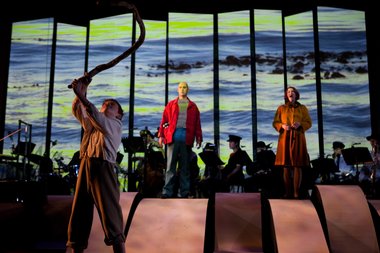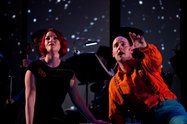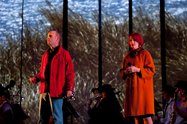John Hurrell – 11 September, 2012
This is a separate type of artwork then, this opera, than the art that Lye was involved with. It has its own existence on different terms, part of another tradition. As contemporary opera in the tradition of Philip Glass and Robert Wilson, this example of Eve de Castro-Robinson's music may be superlative for its type, as is perhaps another New Zealand contemporary opera, Jack Body's Alley? I can't tell, though it is not ‘over the top' as spectacle, instead being comparatively intimate.
Auckland
Len Lye the Opera
Individual Happiness Now
5 - 8 September 2012
It is difficult to assess precisely how well known Len Lye (1901-1980) is overall in this country - outside of the art community to which his New York and London works were first exposed posthumously in the eighties, and beyond Taranaki where he has been a tourist attraction at the Govett-Brewster for many years and where a special centre is now being built to exhibit his works. I’d love to think he is a ‘household name’ but don’t believe it is true. No NZ artist is that famous.
Now we have his extraordinary life story converted into an opera, with music in that genre written by Eve de Castro-Robinson, a prominent New Zealand composer who teaches at Auckland University’s School of Music and a libretto written by Roger Horrocks, Lye’s tenacious biographer and a tireless champion of his work. It is a fine sounding, colourful and vibrant show with a small orchestra ably conducted by musical director Uwe Grodd and a cast and chorus of twenty-two directed by Murray Edmond, the poet and drama lecturer.
Opera does not happen to be a passion of mine but to my limited ear the music here has all the traditional structures I’d expect of opera, the conventional phrasings and cadences for the generic types of operatic voice, but mixed in - in de Castro-Robinson’s case - with the dissonances of early twentieth century modernist music and occasionally, the blues-tinged jazz or field hollers that Lye loved, and which ‘drove’ his highly rhythmic films.
The story of Lye’s remarkable life is engrossing, and there is no better biography of any New Zealand artist anywhere than Horrocks’ beautifully structured historical account of this innovative personality - lucid and packed with amazingly interesting detail. So why did Horrocks collaborate with de Castro-Robinson and write a libretto for her music? The answer is obvious. He is the ultimate eloquent Lye proselytiser, one also deeply curious and enthusiastic about many forms of music, and friends with lots of musicians. More importantly he loves turning new audiences onto Lye’s work, helping them discover the physicality and background ideas of this artist’s life project. It makes sense that he took on an opera to promote an artist he is so passionate about, for it allows him to try out creative ideas for writing, like having three performers portray Lye at different ages.
Surprisingly, in some ways this libretto allows Horrocks to write a critique of some aspects of Lye’s behaviour more hardhitting than in his books. Attractive young women dominate the cast - Lye’s artist friends (especially the male ones) are bypassed - with his philandering given high profile. The priapic nature of his Wind Wand sculptures is alluded to, as is the mental suffering he caused his patient and incredibly supportive second wife, Ann.
Lye’s story is told in five acts: five years spread out in five different locations. The sung words from where I was sitting in the circle were hard to decipher (I got snippets). Maybe it was the building’s acoustics, perhaps I’m just not familiar with the aural conventions of the genre’s musical voice types - even when they’re in an English not Italian form - but I managed to guess the identity of a lot of the personalities because of my familiarity with Horrocks’ books. To read a copy of the libretto or to hear the performances on CD would be different experiences entirely.
The key questions that come to mind are how do you respond to such a musical event in the context of Lye’s work, and why did it come to be? You have to ask that last question because to me anyway, an opera goes against the grain of what he stood for. Lye’s art possesses a primal immediacy - it is loud (optically bright and aurally with volume), usually possessing a bodily penetration opera as a rule does not have. The latter instead is loaded up with cultural mediation as a form of musical theatre that has to be then decoded. One is ‘raw’, the other is ‘cooked’.
To experience Lye’s films and kinetic sculpture firsthand you usually have to go to New Plymouth. And that encounter can be just as often terrifying as jubilant, especially if there is lots of kinetic sculpture on display. Therefore there is an argument that any ‘translation’ of Lye’s art as content for an opera can only be a farcical watering down - if you think it is trying to represent his work.
But of course this opera does not claim to feature Lye’s art firsthand, only present him as a creative charismatic personality with a fascinating story to tell, a life around which to wrap some new music.
This is a separate type of artwork then, this opera, than the art that Lye was involved with. It has its own existence on different terms, part of another tradition. As contemporary opera in the tradition of Philip Glass and Robert Wilson, this example of Eve de Castro-Robinson’s music may be superlative for its type, as is perhaps another New Zealand contemporary opera, Jack Body’s Alley? I can’t tell, though it is not ‘over the top’ as spectacle, instead being comparatively intimate. I enjoyed the colour, the tunes, the innovative idea of Lye’s bio as narrative subject matter, and the use of the whole theatre as space, involving the movement of the chorus around the side wings of the stage and the brief presence of some of the cast in the high mezzanine circle where I sat.
However in the end my earlier argument that the structuring operatic ‘template’ is insufficiently bodily and too tasteful seems apt. The opera misses out on the extremism of much of Lye’s character and art, its startlingly confrontational aspects (daring you to stand close), its use of controlled terror. A quibble that is relevant because the spirit of Lye can’t be pried away from his biography. It has become comparatively muted, excessively tamed.
John Hurrell
Recent Comments
Roger Horrocks
It's interesting to read a discussion of the opera from people such as yourselves who know a lot about Lye. ...
Tony Green
It is difficult to know how well-known any artist's work is and even harder to know what that well-knownness may ...
Owen Pratt
It is perhaps better not to have big expectations of a live production and everything about this one was entirely ...











 Advertising in this column
Advertising in this column Two Rooms presents a program of residencies and projects
Two Rooms presents a program of residencies and projects



This Discussion has 5 comments.
Comment
Owen Pratt, 8:13 a.m. 12 September, 2012 #
I had very high expectations for this production. The performance may have improved after the interval but I wouldn't know. The score was rhythmic and percussive but not kinetically so, and completely lacking in melody; the libretto trite (but that is an operatic convention), the stage setting cluttered and awkward considering the idea was to honour a sculptor,
Shirley Horrocks' projections repeated the libretto but were distracting and must have been blinding for the musicians projected upon. When Len Lye's scratch films were used they were too small for the stage which, like you say, just served to water them down.
Considering the wealth of talent brought to bear on such a fascinating subject, it is surprising, to say the least, that the target was missed by such a wide margin. I think this will be a production that will slip quietly and thankfully into obscurity.
John Hurrell, 10:57 a.m. 12 September, 2012 #
I liked the music (though I don't have the vocabulary to analyse it) and the event as a whole. However Lye has a one-to-one relationship to his audience. You feel he is addressing you alone in a very private way. The opera was something quite different. Some films can create such an intimacy and maybe some opera too - though not this one.
Owen Pratt, 12:29 p.m. 12 September, 2012 #
It is perhaps better not to have big expectations of a live production and everything about this one was entirely competent. The best opera soars and elevates the human condition, as does Lye's film and sculpture, so an operatic treatment could be a good fit for the subject. Not here though.
Tony Green, 8:02 a.m. 15 September, 2012 #
It is difficult to know how well-known any artist's work is and even harder to know what that well-knownness may amount to.
How much it was exhibited or shown in cinemas is another matter.
Fortunately Len Lye didn't have to wait until he was dead, as your review suggests, for showing of his paintings [1930s] and movies [common enough to see them in the spot used in cinema programmes for 'cartoons' in Britain in 1930s & 40s] or exhibition of his kinetic sculpture [1960s& 70s].
Roger Horrocks, 4:50 p.m. 18 September, 2012 #
It's interesting to read a discussion of the opera from people such as yourselves who know a lot about Lye. I have had more feedback from this project than from almost anything I've ever done, and I have been amazed to learn how few people know anything about Lye, beyond having perhaps heard his name. Granted, this project sought deliberately to reach outside the visual arts community to people with an interest in opera, theatre, etc. In that sense I think I'm justified in saying that the project was highly successful in terms of getting people interested in Lye. The response has been highly positive and there has been a big demand for more information about him.
The only negative feedback I'm aware of has been from several people who already knew a lot about him and either think (as John suggests) that the very idea of 'translating' art to another medium is an act of 'watering down' or who have a strong view of their own as to how Lye should have been presented.
Such perspectives are perfectly valid, and personally I'm grateful for any attention that the project has received. But as someone with a foot in music as well as a foot in the visual arts, I would suggest to you that the work looks very different if it is approached as a contemporary opera, in opera terms. When someone says the music was "completely lacking in melody" I can only say: Well, here's someone who probably knows a lot about the visual arts but who certainly has no ear for modern music. He isn't the only person of that kind in the arts community - and over in the music world, there'd be some opera musicians who can't make any sense of contemporary art. Interestingly, there will probably also be a few of Eve's musical colleagues who'd regard the opera as TOO melodic (it includes some very catchy music).
As they say, you can please some of the people some of the time.... Anyway, thank you all for your interest in the project.
Participate
Register to Participate.
Sign in
Sign in to an existing account.